Shipping a cat can be a daunting task, filled with uncertainties and questions. As a pet owner, you want to ensure the safety and well-being of your feline companion throughout the journey. In this article, I will provide answers to common queries regarding how to ship a cat safely, addressing concerns related to cat transportation, cat shipping, and cat relocation.
Key Takeaways:
- Shipping a cat involves careful planning and preparation for a smooth and stress-free journey.
- Research the pet travel requirements of the destination country and obtain the necessary health documents and vaccines.
- Choose an airline with established pet policies and a good track record of caring for animals.
- Ensure your cat’s safety by acclimating them to their travel crate and avoiding the use of sedatives.
- Consider the costs and evaluate if shipping your cat is the best option for your specific situation.
Understanding Pet Travel Requirements
When it comes to shipping your cat, it’s important to be familiar with the pet travel requirements to ensure a smooth and safe journey. Before embarking on this process, research the import instructions from the destination country’s official Ministry of Agriculture website or rely on reliable sources like IATA or PetRelocation. These sources provide comprehensive guidelines and information regarding health documents, vaccines, and quarantine regulations. For a detailed understanding of specific country requirements and quarantine instructions, visit PetRelocation’s website.
Examples of Pet Travel Requirements:
Below is a summary of some common pet travel requirements:
- Import permits
- Health certificates
- Vaccination records
- Microchipping
- Quarantine regulations
Make sure you have all the necessary documentation and follow the guidelines provided by the destination country.
Understanding the pet travel requirements not only ensures compliance with regulations but also contributes to the overall safety and well-being of your cat throughout the journey.
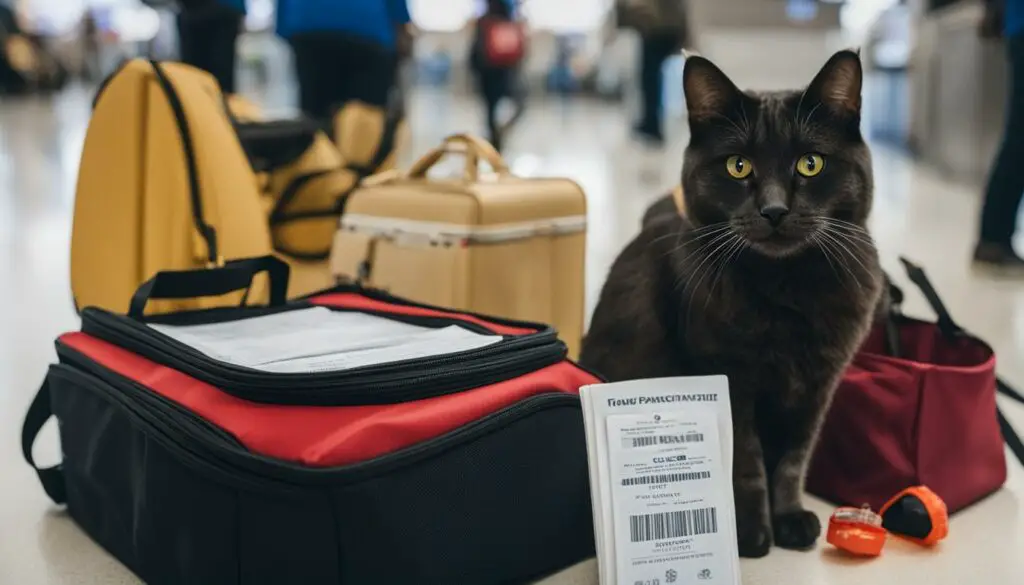
Choosing the Right Airline for Cat Travel
When it comes to traveling with your cat, selecting the right airline is essential for a safe and comfortable journey. Not all airlines are created equal when it comes to pet-friendly services and travel safety measures. To ensure the best experience for your feline companion, consider the following factors when choosing an airline:
- Established Pet Policies: Look for airlines with established pet policies that outline their procedures and requirements for traveling with pets. These policies should provide clear guidelines on crate requirements, documentation, and any additional fees.
- Solid Safety Measures: Safety should be a top priority when it comes to pet travel. Research the airline’s safety record and inquire about their specific measures for ensuring the well-being of pets during the journey. This may include climate-controlled cargo holds, trained staff, and protocols for handling pets during layovers.
- Positive Customer Reviews: Take the time to read customer reviews and feedback regarding the airline’s pet travel services. Look for positive experiences and testimonials that highlight the airline’s commitment to pet safety and comfort.
While there are several airlines that provide excellent pet travel services, some stand out as particularly pet-friendly. KLM, for example, offers a dedicated Pet Lounge at Amsterdam Airport Schiphol, where pets can relax and exercise before their flights. Lufthansa has a well-established Animal Lounge at Frankfurt Airport, which features spacious accommodations and professional care. Qantas, the flagship carrier of Australia, has consistently been recognized for its exceptional pet travel services.
By choosing an airline with established pet policies, solid safety measures, and positive customer reviews, you can ensure that your cat will have a safe and comfortable journey to their destination.
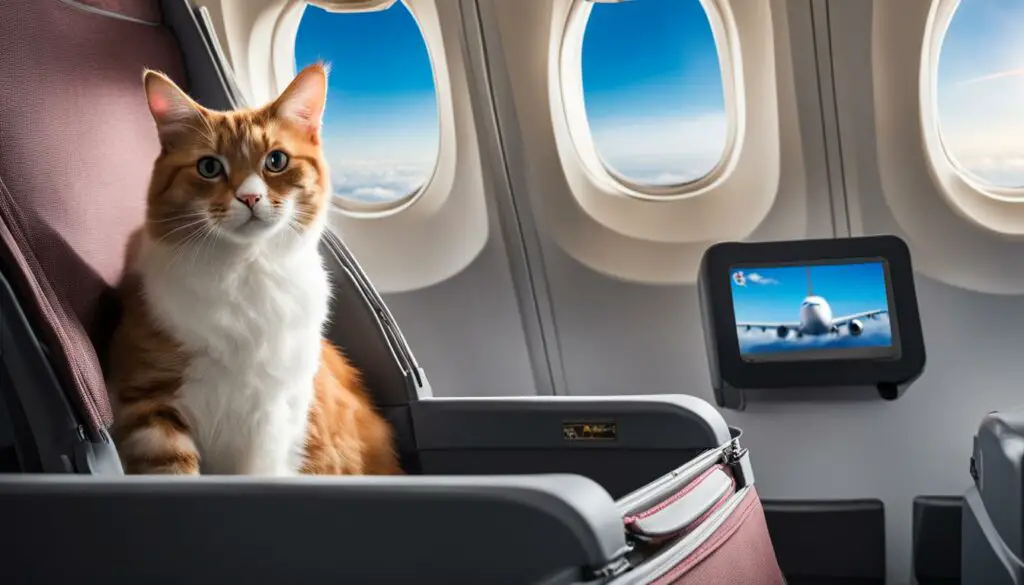
Ensuring the Safety of Your Cat
When it comes to shipping your cat, their safety should be your top priority. Taking the necessary precautions and being prepared can help ensure a smooth and stress-free journey for your feline friend.
Preparing Your Cat Physically
Before the travel day, it’s important to ensure that your cat is in good physical shape. Schedule a visit to the veterinarian for a thorough check-up and make sure all vaccinations are up to date. Additionally, ensure that your cat is properly hydrated by providing plenty of fresh water in the days leading up to the journey.
One key factor in preparing your cat for travel is helping them acclimate to their travel crate. Place the crate in a familiar and comfortable area of your home and gradually introduce your cat to it. Allow them to enter and explore the crate on their own terms, leaving the door open for them to come and go as they please. This will help reduce anxiety and make the crate a more familiar and safe space for your cat.
Creating a Cat Travel Checklist
Before embarking on the journey, it’s essential to create a cat travel checklist to ensure you have all the necessary essentials. The checklist may include items such as:
- A secure and properly sized travel crate
- Food and water bowls
- Comfortable bedding
- Identification tags and a collar
- Any necessary medications
- Favorite toys or familiar items to provide comfort
Having a checklist will help you stay organized and ensure that you have everything you need for your cat’s well-being during the journey.
By prioritizing your cat’s safety and taking the necessary steps to prepare them for travel, you can help ensure a safe and comfortable journey for your beloved feline companion.
| Essential Cat Travel Checklist |
|---|
| A secure and properly sized travel crate |
| Food and water bowls |
| Comfortable bedding |
| Identification tags and a collar |
| Any necessary medications |
| Favorite toys or familiar items to provide comfort |
Understanding the Cost of Shipping a Cat
When it comes to shipping a pet, particularly a cat, there are several costs to consider. From import permits to health certificates, customs clearance to delivery fees, and plane tickets, the expenses can add up. However, many pet owners believe that these costs are worth it for the safety and well-being of their furry companions.
Shipping a cat by air involves various expenses, and it’s essential to factor them into your budget. Each country may have different regulations and requirements, which can affect the overall cost. Additionally, the size and weight of your cat, as well as the distance of the journey, can also impact the final price.
To help you understand the potential costs involved, here is a breakdown of the key expenses to consider when shipping a cat:
| Expense | Estimated Cost |
|---|---|
| Import permits | $50 – $200 |
| Health certificates | $50 – $100 |
| Customs clearance | $100 – $500 |
| Delivery fees | $200 – $500 |
| Plane tickets | $200 – $1500 |
Please note that these are estimated costs and can vary depending on several factors such as the destination, airline, and additional services required. It’s always best to consult with a reputable pet shipping company or agent for an accurate quote tailored to your specific needs.
While shipping a cat can be expensive, many pet owners find the peace of mind and assurance of their cat’s safety during the journey to be priceless. By carefully evaluating the costs and considering the well-being of your cat, you can make an informed decision about whether shipping your cat by air is the right choice for you.
Considering Whether to Move Your Cat
If you’re contemplating a move abroad and you have a furry feline friend, it’s important to carefully consider whether it’s in your cat’s best interest to join you on the journey. While some cats adapt well to travel and new environments, others may struggle with the stress and potential health risks that come with long-distance travel.
Before making a decision, take into account your cat’s age and overall health. Older cats or those with pre-existing medical conditions may not be suitable candidates for long journeys. Additionally, consider the specific travel restrictions and regulations of your destination country. Some countries have strict requirements for pet imports, including quarantine periods and mandatory vaccinations. Researching these restrictions beforehand can help you make an informed decision.
Factors to Consider
- The time and stress involved in international travel
- Any potential health risks for your cat
- The costs associated with transporting your cat
It’s also crucial to discuss your plans with your veterinarian and a pet relocation specialist. They can provide valuable insight into your cat’s specific needs and help you navigate the complexities of pet travel. Ultimately, the well-being and happiness of your cat should be the top priority when deciding whether to move them abroad.

Exploring Pet Transport Services
When it comes to shipping your cat, hiring a reputable pet transport service can make the entire process much smoother and less stressful. Pet transport services are experienced in handling the complex requirements and regulations involved in shipping pets, ensuring that your cat is well-cared for throughout the journey. They can provide guidance, handle paperwork, and ensure the safety and well-being of your furry friend.
By using a pet transport service, you can have peace of mind knowing that experts are taking care of every aspect of your cat’s transportation. They are familiar with the pet travel requirements and regulations of different countries, and can help ensure that you have all the necessary documentation in order. Whether it’s obtaining the right permits, health certificates, or complying with quarantine regulations, a pet transport service can handle it all.
Additionally, pet transport services have the knowledge and resources to provide your cat with a comfortable and stress-free journey. They can advise you on the best travel crate for your cat, help you prepare your cat for travel, and even offer assistance in reducing travel anxiety. With their expertise, you can rest assured that your cat will be safe and well-cared for throughout the entire shipping process.
| Benefits of Pet Transport Services |
|---|
| Expert knowledge of pet travel requirements and regulations |
| Assistance with obtaining necessary permits and documentation |
| Advice on preparing your cat for travel and reducing anxiety |
| Ensuring the safety and well-being of your cat throughout the journey |
When selecting a pet transport service, be sure to choose a reputable and reliable company. Look for reviews and recommendations, and check if they are accredited by organizations such as the International Pet and Animal Transportation Association (IPATA). By entrusting your cat’s transportation to a professional pet transport service, you can ensure a smooth and hassle-free experience for both you and your beloved feline companion.
Understanding Live Animal Shipping Requirements
When it comes to live animal shipping, including shipping cats by air, it is essential to adhere to the guidelines and requirements set by IATA (International Air Transport Association) for the safe transport of animals. These regulations apply not only to pet relocations but also to shipping animals for zoological purposes and even transporting racehorses.
When making a reservation for your cat’s journey, there are several factors to consider. The specific species being shipped, such as a domestic cat, will determine the container requirements, as well as any additional regulations imposed by the airline and country of import. It is crucial to research and understand these requirements in order to ensure a smooth and successful shipping process.
Compliance with airline animal shipping requirements is essential to the well-being of your cat during transport. This includes selecting an airline that has established protocols for handling live animals and a proven track record of safe transport. Additionally, proper labeling and marking of the container are crucial to facilitate correct handling and minimize the risk of mishaps or injuries. By following these requirements, you can help ensure the safety and comfort of your feline companion throughout their journey.
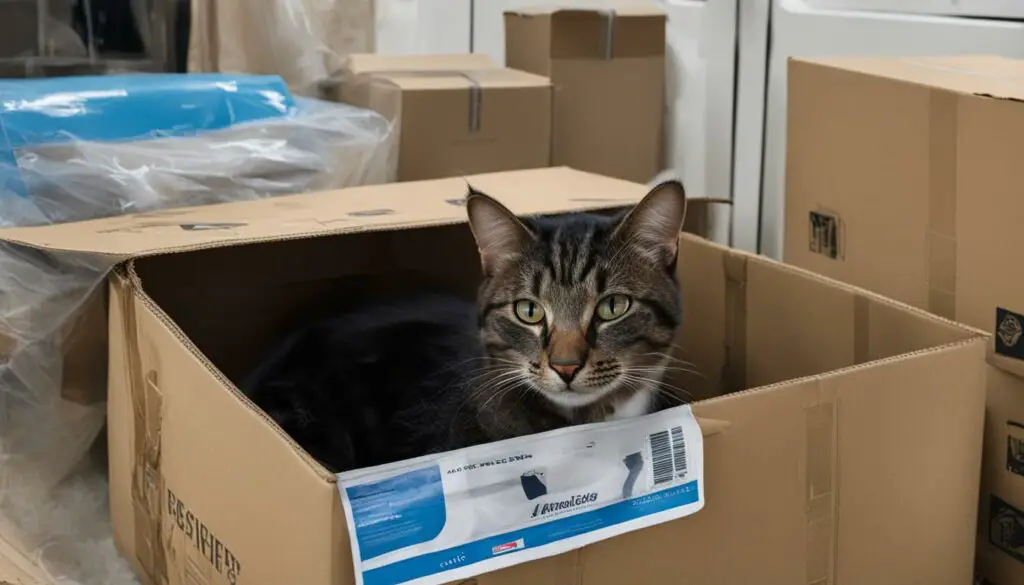
Table: Summary of Live Animal Shipping Requirements
| Requirement | Description |
|---|---|
| Container Specifications | Containers must comply with IATA regulations, providing proper ventilation, security, and space for the cat. |
| Carrier Regulations | Each airline may have specific guidelines and restrictions for shipping live animals, including cats. |
| Country Regulations | Importing countries may have additional rules and regulations regarding the transportation of live animals. |
| Correct Marking and Labeling | Containers must be clearly labeled with appropriate information, including live animal labels, destination, and contact details. |
| Routing Restrictions | Some countries may have specific routing requirements or restrictions on certain species. |
By understanding and complying with the live animal shipping requirements, you can ensure the safety and well-being of your cat during their journey. Always consult with the airline and follow the guidelines provided by IATA and other relevant authorities to make the shipping process as smooth and stress-free as possible.
Necessary Documents for International Cat Shipping
When you’re planning to ship your cat internationally, there are several necessary documents you need to have in order to ensure a smooth and successful journey. These documents are essential for compliance with the regulations and requirements of both the exporting and importing countries. Here are the key documents you should be prepared to provide:
1. Cat Travel Health Certificate
A cat travel health certificate is a crucial document that verifies your cat’s health and vaccination status. This certificate is issued by a licensed veterinarian and should include essential information such as the cat’s identification details, vaccination records, and a statement confirming that your cat is in good health and suitable for travel.
2. Cat Travel Quarantine Documents
Depending on the destination country, your cat may be subject to quarantine upon arrival. It’s important to research and understand the quarantine requirements of the country you’re shipping your cat to. Some countries may require specific quarantine certificates or documentation to ensure that your cat meets their health and safety standards.
3. CITES Documents (If Applicable)
CITES (Convention on International Trade in Endangered Species of Wild Fauna and Flora) permits may be required if your cat belongs to a species protected by CITES regulations. These permits are necessary to ensure that the international trade of endangered species is regulated and controlled. If your cat falls under this category, you will need to obtain the necessary CITES documents before shipping internationally.
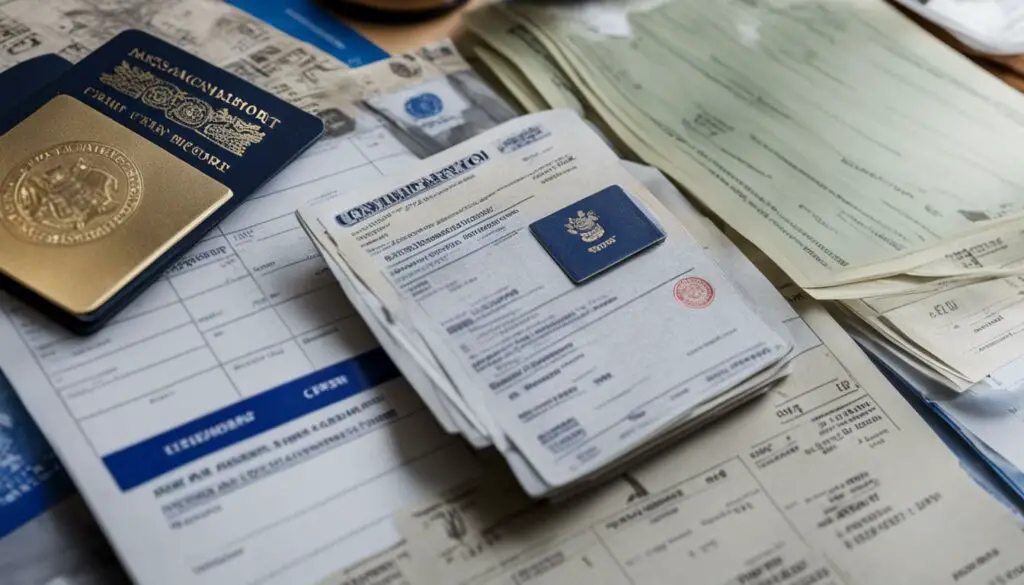
Remember to contact the appropriate embassy or consulate of the destination country to obtain accurate and up-to-date information on the specific documentation requirements. Failure to provide the necessary documents can result in delays or even refusal of entry for your cat. Proper preparation and attention to detail will help ensure a smooth and stress-free international shipping experience for your beloved feline companion.
Responsibilities of the Shipper and Carrier
When it comes to shipping a cat, there are specific responsibilities that both the shipper and the carrier must adhere to. As the shipper, it is your duty to ensure that your cat is properly prepared for transport. This includes filling out any necessary paperwork, such as health certificates and import permits, and ensuring that your cat is housed in an appropriate travel crate or carrier. Additionally, it is your responsibility to provide all the necessary information to the carrier, including any specific requirements or instructions for the transport of your cat.
On the other hand, the carrier is responsible for the overall welfare and safe transport of your cat. This includes reviewing all documentation provided by the shipper, such as health certificates and import permits, to ensure that everything is in order. The carrier is also responsible for properly loading the cat into the aircraft hold and ensuring that it is delivered safely to its destination. Additionally, the carrier should have protocols in place to handle any unforeseen circumstances or emergencies that may arise during transit.
“The shipper’s responsibilities include preparing the cat for transport, filling out necessary paperwork, and ensuring proper containers and labeling.”
“The carrier is responsible for the welfare and safe transport of the cat, including reviewing documentation, loading the cat into the aircraft hold, and delivering it safely to the destination.”
It is important to note that in some cases, freight forwarders may also play a role in the shipping process. Freight forwarders can assist with the handling and documentation of live animals, ensuring that all necessary paperwork is in order and that all regulations and requirements are met. If you choose to work with a freight forwarder, it is essential to communicate effectively and provide them with all the information they need to facilitate the smooth transport of your cat.
Summary:
When shipping a cat, both the shipper and the carrier have specific responsibilities to ensure the safe and proper transport of the animal. The shipper is responsible for preparing the cat for transport, filling out necessary paperwork, and ensuring proper containers and labeling. The carrier, on the other hand, is responsible for the overall welfare and safe transport of the cat, including reviewing documentation, loading the cat into the aircraft hold, and delivering it safely to the destination. Freight forwarders may also play a role in the shipping process, assisting with the handling and documentation of live animals.
Ensuring Animal Welfare During Transport
When it comes to shipping animals, including cats, ensuring their welfare during transport is of utmost importance. Understanding animal behavior during travel, adhering to animal transportation guidelines, and meeting container requirements are key factors in creating a safe and comfortable journey for your feline friend.
During transport, it’s crucial to consider how animals behave in unfamiliar environments. Cats may experience stress, anxiety, or digestive issues during travel. By providing a secure and comfortable space, you can help alleviate their concerns. Ensure the transport container is properly ventilated, providing sufficient airflow while maintaining security.
Animal transportation guidelines provide valuable insights into best practices for shipping pets. These guidelines address topics such as handling, loading, and unloading procedures, as well as the use of appropriate restraints and protective measures. By following these guidelines, you can minimize the risk of injury and ensure the well-being of your cat throughout the journey.
Container requirements play a significant role in maintaining animal welfare during transport. Containers should be spacious enough for the cat to stand, turn around, and lie down comfortably. They should also be secure, preventing any potential escapes or injuries. Proper marking and labeling on the container help identify its contents and ensure appropriate handling throughout the shipping process.

Animal Behavior During Transport
Understanding how animals behave during transport can help you create a more comfortable and stress-free experience for your cat. Some common behaviors to consider include:
- Increased vocalization
- Restlessness or pacing
- Loss of appetite
- Increased or decreased sleep
- Changes in elimination habits
Being aware of these behaviors can help you identify if your cat is experiencing any distress during transport. If necessary, consult a veterinarian for advice on managing your cat’s behavior and well-being during the journey.
| Container Requirements | Marking and Labeling |
|---|---|
| Spacious enough for cat to move comfortably | Clearly mark container as live animal shipment |
| Secure and escape-proof | Include owner’s contact information |
| Proper ventilation to ensure airflow | Indicate direction of upright position |
| Clean and free of any hazards | Attach feeding and care instructions |
The Role of Documentation in Pet Shipping
When it comes to shipping a pet, proper documentation is crucial to ensure a smooth and hassle-free experience. The right paperwork helps to ensure that your beloved furry friend is transported safely and in compliance with all necessary regulations. In this section, I will discuss the essential documents needed for pet shipping and provide insights into the importance of each one.
Key Documentation for Pet Shipping
1. IATA Live Animal Acceptance Checklist: This document, provided by the International Air Transport Association (IATA), outlines the requirements for transporting live animals. It includes important information about container specifications, labeling, and handling procedures. The checklist serves as a comprehensive guide for pet shippers and airlines, ensuring compliance with international standards.
“Pets are often considered part of the family, and their safety and well-being during transport are paramount. The IATA Live Animal Acceptance Checklist plays a vital role in standardizing the procedures and ensuring that the highest level of care is provided to pets during their journey.”
2. Shipper’s Certification: This document is issued by the pet owner or the authorized agent responsible for shipping the pet. It certifies that the owner has fulfilled all the necessary requirements for the transport, including health documentation, vaccinations, and compliance with quarantine regulations. The shipper’s certification acts as proof that the pet is fit for travel and meets all the necessary conditions.
3. Air Waybill: The air waybill is a crucial document that serves as a contract between the shipper, the airline, and the consignee. It contains essential information about the pet’s origin, destination, flight details, and payment terms. The air waybill acts as a tracking document, allowing the shipper and the consignee to monitor the pet’s journey throughout the shipping process.
Streamlining the Documentation Process
Managing the necessary paperwork for pet shipping can be overwhelming, especially when dealing with international regulations. Fortunately, there are modern solutions to streamline the documentation process. Electronic systems and online platforms, such as e-freight systems, enable pet owners and shippers to submit and manage their documentation digitally. These platforms reduce the risk of errors, improve efficiency, and provide a more convenient experience for all parties involved.
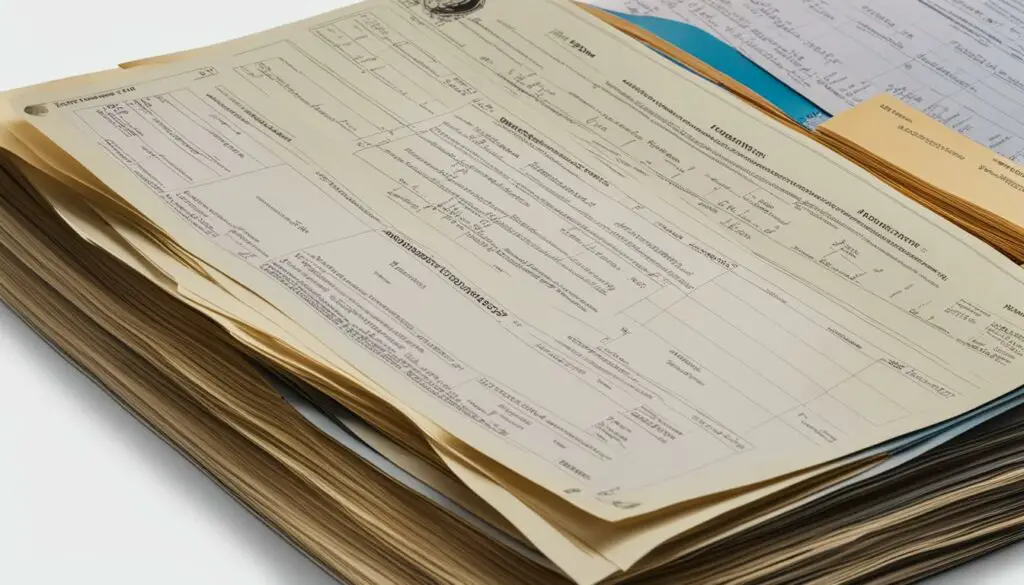
Proper documentation is the foundation of a successful pet shipping experience. By ensuring that you have the necessary paperwork, following industry standards, and utilizing modern documentation systems, you can navigate the complexities of pet shipping with confidence and peace of mind.
Conclusion
As a cat owner, ensuring the safe and stress-free travel of your beloved feline companion is of utmost importance. Whether you’re relocating domestically or internationally, utilizing the services of reputable pet transport companies can make the entire process more manageable.
When it comes to pet relocation, there are various factors to consider, including the specific needs of your cat and compliance with travel regulations. Professional pet transport services have the expertise to handle all the necessary paperwork, ensure your cat’s comfort during the journey, and navigate any country-specific requirements.
By entrusting your cat’s travel to experienced professionals, you can have peace of mind knowing that every aspect of the journey, from documentation to container requirements, will be properly handled. These pet shipping companies prioritize the well-being and safety of your feline friend, making the process as smooth and stress-free as possible.
So, if you’re planning a pet relocation or need to transport your cat for any reason, consider working with reputable pet transport services. They will take care of the logistics, allowing you to focus on ensuring a comfortable and safe journey for your beloved cat.
FAQ
What are the travel requirements for shipping a cat?
Research the import instructions from the destination country’s official Ministry of Agriculture website or use reliable sources like IATA or PetRelocation. Make sure you have the necessary health documents, vaccines, and are aware of any quarantine regulations.
How do I choose the right airline for shipping my cat?
Look for airlines with established pet policies, solid safety measures, and a good track record of caring for animals. Airlines like KLM, Lufthansa, and Qantas are known for their pet-friendly services.
How can I ensure the safety of my cat during shipping?
Prepare your cat physically by keeping them in good shape and properly hydrated. Help them acclimate to their travel crate to reduce anxiety. Avoid sedatives, as they are not permitted and may not be safe for your cat.
What are the costs involved in shipping a cat?
Shipping a cat involves various costs, including import permits, health certificates, customs clearance, delivery fees, and plane tickets. Consider the costs involved and evaluate if shipping your cat is the best option for your specific situation.
Should I consider moving my cat?
Relocations may make cat travel necessary, but older cats or those in delicate health may not be suitable for long journeys. Discuss with your vet and pet relocation specialist to determine if moving your cat is the best choice.
How can a pet transport service help with shipping my cat?
Pet transport services are experienced in handling pet travel requirements, regulations, and logistics. They can provide guidance, handle paperwork, and ensure the safety and well-being of your cat throughout the journey.
What are the requirements for live animal shipping?
When shipping live animals by air, it is crucial to follow the IATA Live Animals Regulations. Consider the species being shipped, correct container requirements, carrier regulations, country regulations, and the most appropriate routing allowed by the importing country.
What documents are required for international cat shipping?
Specific documents are required for international cat shipping, including an import permit, health certification, and a shipper’s certificate. Depending on the country and species, additional documents like CITES permits may also be necessary.
What are the responsibilities of the shipper and carrier when shipping a cat?
The shipper is responsible for preparing the cat for transport, filling out necessary paperwork, and ensuring proper containers and labeling. The carrier is responsible for the welfare and safe transport of the cat, including reviewing documentation, loading the cat into the aircraft hold, and delivering it safely to the destination.
How can I ensure animal welfare during cat transport?
Familiarize yourself with animal behavior during travel and follow specific guidelines to create a safe and comfortable environment for your cat. Ensure that containers meet necessary requirements, such as proper ventilation and security, and mark and label them correctly.
What role does documentation play in pet shipping?
Various documents are required for pet shipping, including the shipper’s certification, air waybill, CITES documents (if applicable), and the IATA Live Animal Acceptance Checklist. Take the time to understand the necessary paperwork for a smooth pet shipping process.
How can I make the process of shipping my cat smoother?
With careful planning and the assistance of pet transport services, shipping a cat can be a smooth and stress-free experience. Consider the individual needs of your cat, follow necessary requirements and regulations, and prioritize their safety and well-being.







